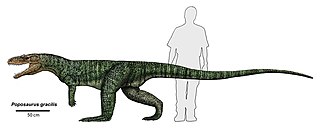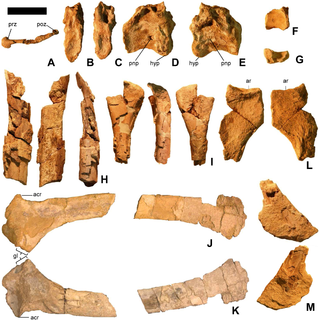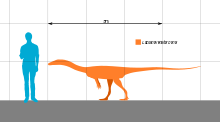
Camposaurus is a coelophysid dinosaur genus from the Norian stage of the Late Triassic period of North America. The pertinent fossil remains date back to the early to middle Norian stage, and is widely regarded as the oldest known neotheropod.

Huabeisaurus was a genus of dinosaur from the Late Cretaceous. It was a sauropod which lived in what is present-day northern China. The type species, Huabeisaurus allocotus, was first described by Pang Qiqing and Cheng Zhengwu in 2000. Huabeisaurus is known from numerous remains found in the 1990s, which include teeth, partial limbs and vertebrae. Due to its relative completeness, Huabeisaurus represents a significant taxon for understanding sauropod evolution in Asia. Huabeisaurus comes from Kangdailiang and Houyu, Zhaojiagou Town, Tianzhen County, Shanxi province, China. The holotype was found in the unnamed upper member of the Huiquanpu Formation, which is Late Cretaceous (?Cenomanian–?Campanian) in age based on ostracods, charophytes, and fission-track dating.

Nanshiungosaurus is a genus of therizinosaurid that lived in what is now Asia during the Late Cretaceous of South China. The type species, Nanshiungosaurus brevispinus, was first discovered in 1974 and described in 1979 by Dong Zhiming. It is represented by a single specimen preserving most of the cervical and dorsal vertebrae with the pelvis. A supposed and unlikely second species, "Nanshiungosaurus" bohlini, was found in 1992 and described in 1997. It is also represented by vertebrae but this species however, differs in geological age and lacks authentic characteristics compared to the type, making its affinity to the genus unsupported.
Lophostropheus is an extinct genus of coelophysoid theropod dinosaur that lived approximately 205.6 to 196.5 million years ago during the boundary between the Late Triassic Period and the Early Jurassic Period, in what is now Normandy, France. Lophostropheus is one of the few dinosaurs that may have survived the Triassic–Jurassic extinction event.

Poposauroidea is a clade of advanced pseudosuchians. It includes poposaurids, shuvosaurids, ctenosauriscids, and other unusual pseudosuchians such as Qianosuchus and Lotosaurus. It excludes most large predatory quadrupedal "rauisuchians" such as rauisuchids and "prestosuchids". Those reptiles are now allied with crocodylomorphs in a clade known as Loricata, which is the sister taxon to the poposauroids in the clade Paracrocodylomorpha. Although it was first formally defined in 2007, the name "Poposauroidea" has been used for many years. The group has been referred to as Poposauridae by some authors, although this name is often used more narrowly to refer to the family that includes Poposaurus and its close relatives.

The vertebral column, also known as the spinal column, spine or backbone, is the core part of the axial skeleton in vertebrate animals. The vertebral column is the defining and eponymous characteristic of the vertebrate endoskeleton, where the notochord found in all chordates has been replaced by a segmented series of mineralized irregular bones called vertebrae, separated by fibrocartilaginous intervertebral discs. The dorsal portion of the vertebral column houses the spinal canal, an elongated cavity formed by alignment of the vertebral neural arches that encloses and protects the spinal cord, with spinal nerves exiting via the intervertebral foramina to innervate each body segments.

Ichthyovenator is a genus of spinosaurid dinosaur that lived in what is now Laos, sometime between 125 and 113 million years ago, during the Aptian stage of the Early Cretaceous period. It is known from fossils collected from the Grès supérieurs Formation of the Savannakhet Basin, the first of which were found in 2010, consisting of a partial skeleton without the skull or limbs. This specimen became the holotype of the new genus and species Ichthyovenator laosensis, and was described by palaeontologist Ronan Allain and colleagues in 2012. The generic name, meaning "fish hunter", refers to its assumed piscivorous lifestyle, while the specific name alludes to the country of Laos. In 2014, it was announced that more remains from the dig site had been recovered; these fossils included teeth, more vertebrae (backbones) and a pubic bone from the same individual.

Martharaptor is a genus of therizinosauroid theropod dinosaurs from the Early Cretaceous of the Cedar Mountain Formation in Utah. They can be distinguished from other therizinosauroids by means of several features of the skeleton which were intermediate between early therizinosaurs such as Falcarius and Beipiaosaurus, and more "advanced" members of the group like therizinosaurids. The deep and homogeneous hand claws clearly differ from the case in early therizinosauroids, but the foot has not yet acquired the robust morphology of therizinosaurids.

Dahalokely is an extinct genus of carnivorous abelisauroid theropod dinosaur from the Late Cretaceous (Turonian) of Madagascar.

Katepensaurus is an extinct genus of rebbachisaurid sauropod dinosaur known from the Late Cretaceous of south-central Chubut Province of central Patagonia, Argentina. It contains a single species, Katepensaurus goicoecheai.
This glossary explains technical terms commonly employed in the description of dinosaur body fossils. Besides dinosaur-specific terms, it covers terms with wider usage, when these are of central importance in the study of dinosaurs or when their discussion in the context of dinosaurs is beneficial. The glossary does not cover ichnological and bone histological terms, nor does it cover measurements.
Datanglong is an extinct genus of theropod belonging to either Carcharodontosauria or Megaraptora. It existed during the Early Cretaceous (Barremian-Albian) in what is now southeastern China.
Panguraptor is a genus of coelophysid theropod dinosaur known from fossils discovered in Lower Jurassic rocks of southern China. The type and only known species is Panguraptor lufengensis. The generic name refers to the deity Pangu but also to the supercontinent Pangaea for which in a geological context the same characters are used: 盘古. Raptor means "seizer", "robber" in Latin. The specific name is a reference to the Lufeng Formation. The holotype specimen was recovered on 12 October 2007 from the Lufeng Formation of Yunnan, which is noted for sauropodomorph fossils. It was described in 2014 by You Hai-Lu and colleagues.

This timeline of coelophysoid research is a chronological listing of events in the history of paleontology focused on the coelophysoids, a group of primitive theropod dinosaurs that were among Earth's dominant predators during the Late Triassic and Early Jurassic epochs. Although formally trained scientists didn't discover coelophysoid fossils until the late 19th century, Native Americans of the modern southwestern United States may have already encountered their fossils. Navajo creation mythology describes the early Earth as being inhabited by a variety of different kinds of monsters who hunted humans for food. These monsters were killed by storms and the heroic Monster Slayers, leaving behind their bones. As these tales were told in New Mexico not far from bonebeds of Coelophysis, this dinosaur's remains may have been among the fossil remains that inspired the story.

Scutarx is an extinct genus of Aetosauriformes, most commonly regarded by its species name Scutarx deltatylus. Scutarx lived around 230 million years ago during the Carnian and Norian stage of the Late Triassic. Scutarx are “medium sized” paramedian osteoderms belonging to the clade Aetosauria, a heavily armored and more herbivorous cousin of crocodiles.

Tratayenia is an extinct genus of megaraptoran theropod dinosaurs known from remains found in the Santonian-age Bajo de la Carpa Formation of Argentina. The type and only species, Tratayenia rosalesi, was described in March 2018.

Nhandumirim is a genus of basal sauropodomorph dinosaur from the Carnian age of Late Triassic Brazil. It is currently considered a saturnaliid sauropodomorph. The type and only species, Nhandumirim waldsangae, is known from a single immature specimen including vertebrae, a chevron, pelvic material, and a hindlimb found in the Santa Maria Formation in Rio Grande do Sul.

Dynamosuchus is an extinct genus of pseudosuchian archosaurs from the family Ornithosuchidae. It is known from a single species, Dynamosuchus collisensis, which is based on a partial skeleton from the Santa Maria Formation of Brazil. Dynamosuchus is considered a close relative of Venaticosuchus, which is known from the Ischigualasto Formation of Argentina. Ornithosuchids are one of many groups which lived in the Santa Maria and Ischigualasto Formations, which formed at approximately the same time and were ecologically similar. As a large scavenging reptile, Dynamosuchus helps to illuminate the trophic structure of the Santa Maria Formation. It also supports the hypothesis that ornithosuchids had diversified throughout South America by the start of the Carnian, and were not originally endemic to the Ischigualasto-Villa Unión Basin.

Incertovenator is an extinct genus of archosauriform reptile, likely an archosaur, of uncertain affinities. Its unstable position is a result of possessing a number features found in both the bird-line avemetatarsalian archosaurs and the crocodylian-line pseudosuchians. The type and only known species is I. longicollum, which is known from single specimen discovered in the Late Triassic Ischigualasto Formation of Argentina. Incertovenator is known almost entirely by its vertebral column. This indicates that it had a relatively long neck, leading to its uncertain classification due to the convergent evolution of elongated neck vertebrae in both avemetatarsalian and pseudosuchian archosaurs.
Pachagnathus is an extinct genus of non-pterodactyloid pterosaur from the late Norian–early Rhaetian-aged Quebrada del Barro Formation of Argentina. It lived in the Late Triassic period, and is one of the only known definitive Triassic pterosaurs from the southern hemisphere. It is also one of the few known continental Triassic pterosaurs, indicating that the absence of early pterosaurs in both the southern hemisphere and terrestrial environments is likely a sampling bias, and not a true absence.































